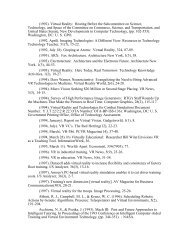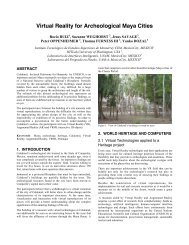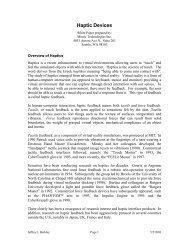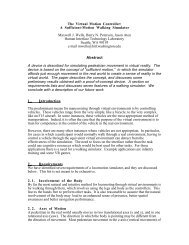A Calculus of Number Based on Spatial Forms - University of ...
A Calculus of Number Based on Spatial Forms - University of ...
A Calculus of Number Based on Spatial Forms - University of ...
You also want an ePaper? Increase the reach of your titles
YUMPU automatically turns print PDFs into web optimized ePapers that Google loves.
39<br />
Pro<str<strong>on</strong>g>of</str<strong>on</strong>g>.<br />
Rati<strong>on</strong>al numbers a; b 2 Q take the form a=([i]) and b=([k]);<br />
where i; k; j; l 2 I with j; l 6= . The product <str<strong>on</strong>g>of</str<strong>on</strong>g> these rati<strong>on</strong>als is also in Q because<br />
the product <str<strong>on</strong>g>of</str<strong>on</strong>g> a and b reduces to the rati<strong>on</strong>al ([m]); where m=([i][k]) and<br />
n=([j][l]):<br />
([ a ][ b ]) Given<br />
([([i])][([k])]) Replacement<br />
( [i] [k] ) Involuti<strong>on</strong><br />
( [i] [k] ) Inverse collecti<strong>on</strong><br />
([([i] [k])]) Involuti<strong>on</strong><br />
([ m ]) Replacement<br />
Since the product <str<strong>on</strong>g>of</str<strong>on</strong>g> two integers is an integer, both m and n are integers. Because<br />
j and l are n<strong>on</strong>-void, n is also n<strong>on</strong>-void. Therefore, ([m]) is rati<strong>on</strong>al and so<br />
the product <str<strong>on</strong>g>of</str<strong>on</strong>g> a and b is rati<strong>on</strong>al.<br />
Every element inQ, except for the void, has a multiplicative inverse.<br />
Pro<str<strong>on</strong>g>of</str<strong>on</strong>g>. Rati<strong>on</strong>al number a 2 Q takes the form a=([i]); where i; k 2 I with<br />
j 6= . Since a is n<strong>on</strong>-void, the numerator is also n<strong>on</strong>-void, i 6= . The multiplicative<br />
inverse <str<strong>on</strong>g>of</str<strong>on</strong>g> a, given by (); is rati<strong>on</strong>al by the following reducti<strong>on</strong> back to the<br />
rati<strong>on</strong>al form.<br />
()=()=()=([j])<br />
5.4.3 Divisi<strong>on</strong> by Zero<br />
Domini<strong>on</strong>, a2=2, loses informati<strong>on</strong> and necessitates excluding from the calculus.<br />
This restricti<strong>on</strong> prevents formati<strong>on</strong> <str<strong>on</strong>g>of</str<strong>on</strong>g> divisi<strong>on</strong> by zero, (): This restricti<strong>on</strong><br />
appears in standard and boundary numbers as:<br />
1=0 undened versus undened.<br />
5.4.4 Calculati<strong>on</strong><br />
Computing a divisi<strong>on</strong> requires a matching <str<strong>on</strong>g>of</str<strong>on</strong>g> quantities. When quantities cannot be<br />
matched, the fracti<strong>on</strong> does not reduce. Thus, the calculus c<strong>on</strong>strains this calculati<strong>on</strong><br />
but does not guide the reducti<strong>on</strong>.












